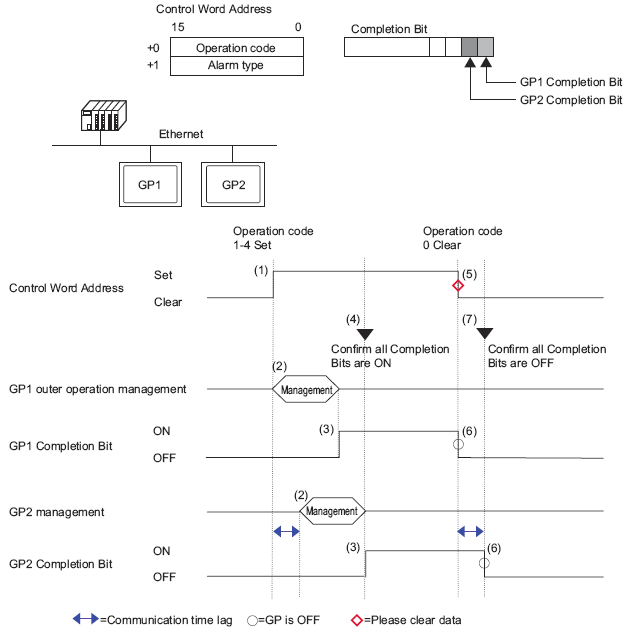
External operations can be performed by multiple display units at one time. However, a time lag will occur due to each display unit's read time, and the order in which the operations are performed and the [Completion Bit] turns ON will differ. Set the operation code after verifying that every [Completion Bit] in each display unit has turned OFF.
Also, when clearing the operation code to "0", ensure that every [Completion Bit] in every display unit has turned ON.
For example:
Using multiple display units (GP1, GP2), set the same address for the [Control Word Address] for external operations, and set separate addresses for the [Completion Bit] of each display unit.

Set the operation code and alarm type in the [Control Word Address] from the PLC.
GP1 and GP2 process orders from the PLC.
When the operations finish, the GP1 and GP2 [Completion Bit] turns ON.
The PLC verifies that each [Completion Bit] in all the display units is now turned ON.
Run the [Control Word Address]'s [Operation Code] "0" (no operation) from the PLC.
When the display unit writes "0" as the [Operation Code], the [Completion Bit] turns OFF.
The PLC verifies that each [Completion Bit] in all the display units are now turned OFF.

In case the power gets turned OFF during the process, set the [Control Word Address] to 0 clear and turn OFF [Completion Bit] for all settings.
While running operations on multiple display units from the PLC, alarms that are triggered or recovered may not be the same on each display unit.
In [Alarm], [Common], when [Print Settings] is set to [Real-time Print], if you run an external operation to acknowledge all within a block, the acknowledge order will be [History], [Log], [Active]. If the same message is registered in both [History] and [Log], the History acknowledge time and Log acknowledge time will both be printed in Real-time, so the same acknowledgment message will be printed twice.